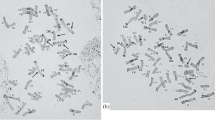Summary
The meiotic behaviour of F1 hybrids of hexaploid Triticale that differed in their genotypic or chromosomic constitution, and diploid rye, was investigated. Meiotic analysis were done by Feulgen and C-banding staining methods. A differential desynaptic effect in the hybrids was detected and explained in terms of genetic differences in pairing regulators. The high homoeologous pairing (A-B wheat chromosomes and wheat-rye chromosomes) observed in the hybrids can be explained in terms of an inhibition of the effect of a single dose of thePh allele of the 5B chromosome produced by two doses of the 5R chromosome. The higher homoeologous pairing detected in the hybrid 188 x ‘Canaleja’ could be the overall result of the balance between thePh diploidizing system (1 dose), the pairing promoter of the 5R chromosome (2 doses) and that of the 3D chromosome (1 dose coming from the parental line Triticale with the substitution 3R by 3D).
Similar content being viewed by others
Literature
Bernard, M.; Bernard, S. (1978): Methods of gene transfer from breed wheat and rye to hexaploid triticale. Proc. 8th Congr. Eucarpia, 181–189
Darvey, N.L.; Gustafson, J.P. (1975): Identification of rye chromosomes in wheat-rye addition lines in Triticale by heterochromatin bands. Crop Sci.15, 239–243
De Vries, J.M.; Sybenga, J.M. (1976): Identification of rye chromosomes: the Giemsa banding pattern and the translocation tester set Theor. Appl. Genet.48, 35–43
Dhaliwal, H.S.; Gill, B.S.; Waines, J.G. (1977): Analysis of induced homoeologous pairing in a Ph mutant wheat x rye hybrid. J. Hered.68, 206–209
Gill, B.S.; Kimber, G. (1974 a): The Giemsa C-banded karyotype of rye. Proc. Nat. Acad. Sci. (Wash.)71, 1247–1249
Gill, B.S.; Kimber, G. (1974 b): Giemsa C-banding and the evolution of wheat. Proc. Nat. Acad. Sci. (Wash.)71, 4086–4090
Gill, B.S.; Kimber, G. (1977): Recognition of translocation and alien chromosome transfers in wheat by the Giemsa-C-banding technique. Crop Sci.17, 264–266
Gustafson, J.P.; Evans L.E.; Josifek, K.K. (1976): Identification of chromosomes inSecale montanum and individualS. montanum chromosome additions to ‘Kharkov’ wheat by heterochromatin bands chromosome morphology. Can. J. Genet. Cytol.18, 339–343
Gustafson, J.P.; Krolow, K.D. (1978): A tentative identification of chromosomes present in tetraploid Triticale based on heterochromatin banding patterns. Can. J. Genet. Cytol.20, 199–204
Hadlaczky, G.Y.; Belea, A. (1975): C-banding in wheat evolutionary cytogenetics. Plant Sci. Letters4, 85–88
Jouve, N.; Montalvo, D. (1978): Meiotic behaviour in hybrids between 6x-Triticale andSecale cereale. Proc. 8th Congr. Eucarpia, 191–197
Jouve, N.; Soler, C.; Saiz, G. (1977): Cytoplasmic effect on the meiosis of 6x-Triticale. Z. Pflanzenzücht.78, 124–134
Kiss, A.; Videki, L. (1971): Development of secondary hexaploid Triticales by crossing triticale by rye. Wheat Inf. Serv.32, 17–20
Krolow, K.D. (1973): 4x-Triticale, production and use in triticale breeding. Proc. 4th Int. Wheat Genet. Symp. 237–244
Lelley, T. (1974): Desynapsis as a possible source of univalents in metaphase I of triticale. Z. Pflanzenzücht.73, 249–258
Mello-Sampayo, T. (1971): Genic regulation on meiotic chromosome pairing by chromosome 3D ofTriticum aestivum. Nature (London) New Biol.230, 22–23
Mello-Sampayo, T.; Canas, A.P. (1973): Suppressors of meiotic chromosome pairing on common wheat. Proc. 4th Int. Wheat Genet. Symp. 709–713
Merker, A. (1973): A Giemsa technique for rapid identification of chromosomes in Triticale. Hereditas75, 280–282
Mettin, D.; Schlegel, R.; Blüthner, W.D.; Weinrich, M. (1976): Giemsa-Banding von MI-Chromosomes bei Weizen-Roggen-Bastarden. Biol. Zbl.95, 35–41
Miller, T.E.; Riley, R. (1972): Meiotic chromosome pairing in wheat-rye combinations. Genet. Iberica24, 241–250
Nakata, N.; Yasumuro, Y.; Sasaki, M. (1977): An acetocarmine-Giemsa staining of rye chromosomes. Jap. J. Genet.52, 315–318
Pohler, W.; Kistner, G. (1977): Meioseuntersuchungen an Triticale.III. Chromosomenanordnung und Chromosomen Paarung bei polyhaploiden Weizen-Roggen-Bastarden. Biol. Zbl.96, 679–691
Riley, R.; Chapman, V.; Miller, T.E. (1973): The determination of meiosis chromosome pairing. Proc. 4th Int. Wheat Genet. Symp. 731–738
Sarma, N.P.; Natarajan, A.T. (1973): Identification of heterochromatic regions in the chromosomes of rye. Hereditas74, 233–238
Schlegel, R. (1977): Intergeneric wheat-rye chromosome pairing and karyotype evolution in the generaSecale. Helsinki Chromosome Conf.
Sears, E.R. (1976): Genetic control of chromosome pairing in wheat. Ann. Rev. Genet.10, 31–51
Singh, R.J.; Röbbelen, G. (1975): Comparison of somatic Giemsa banding pattern in several species of rye. Z. Pflanzenzücht.75, 270–285
Singh, R.J.; Röbbelen, G. (1976): Giemsa banding techniques reveals deletions within rye chromosomes in addition lines. Z. Pflanzenzücht.76, 11–18
Tarkowski, Cz. (1969): Cytogenetics of hexaploid triticale hybrids with wheat and rye. Genet. Polonica10, 85–86
Verma, S.C.; Rees, H. (1974): Giemsa staining and the distribution of heterochromatin in rye chromosomes. Heredity32, 118–122
Vosa, C.G. (1974): The basis karyotype of rye analyzed with Giemsa and fluorescence methods. Heredity33, 403–408
Wall, A.M.; Riley, R.; Gale, M.D. (1971 a): The position of a locus on chromosome 5B ofTriticum aestivum affecting homoeologous meiotic pairing. Genet. Rev.18, 329–339
Wall, A.M.; Riley, R.; Chapman, V. (1971 b): Wheat mutants permitting homoeologous meiotic chromosome pairing. Genet. Rev.18, 311–328
Weimark, A. (1975): Heterochromatin polymorphism in the rye karyotype as detected by the Giemsa C-banding technique. Hereditas79, 293–300
Zeller, F.J. (1973): 1B/1R wheat-rye chromosome substitutions and translocations. Proc. 4th Int. Wheat Genet. Symp. 209–221
Zeller, F.J.; Kimber, G.; Gill, B.S. (1977): The identification of rye trisomies by translocations and Giemsa staining. Chromosoma62, 279–289
Author information
Authors and Affiliations
Additional information
Communicated by R. Riley
Rights and permissions
About this article
Cite this article
Jouve, N., Díez, N. & Rodriguez, M. C-banding in 6x-Triticale xSecale cereale L. hybrid cytogenetics. Theoret. Appl. Genetics 57, 75–79 (1980). https://doi.org/10.1007/BF00745033
Received:
Issue Date:
DOI: https://doi.org/10.1007/BF00745033



